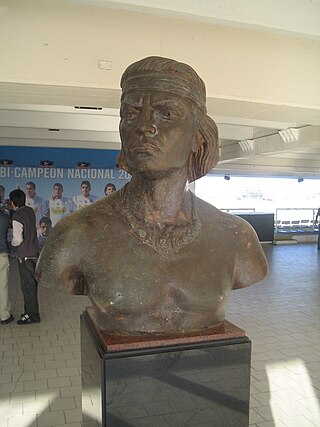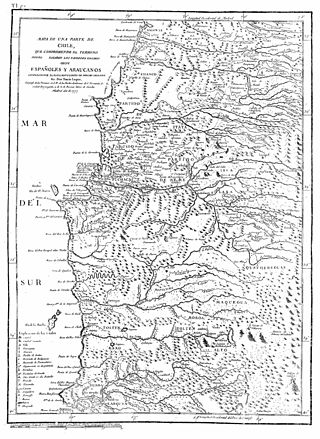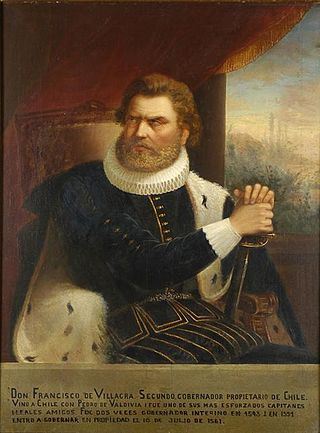Related Research Articles

Colocolo was a Mapuche leader in the early period of the Arauco War. He was a major figure in Alonso de Ercilla y Zúñiga's epic poem La Araucana, about the early Arauco War. In the poem he was the one that proposed the contest between the rival candidates for Toqui that resulted in the choice of Caupolicán. As a historical figure there are some few contemporary details about him. Stories of his life were written long after his lifetime and display many points of dubious historical accuracy.

The Arauco War was a long-running conflict between colonial Spaniards and the Mapuche people, mostly fought in the Araucanía region of Chile. The conflict began at first as a reaction to the Spanish conquerors attempting to establish cities and force Mapuches into servitude. It subsequently evolved over time into phases comprising drawn-out sieges, slave-hunting expeditions, pillaging raids, punitive expeditions, and renewed Spanish attempts to secure lost territories. Abduction of women and war rape was common on both sides.
The Battle of Reynogüelén took place between Spanish conquistadors and Mapuche soldiers, thought to have occurred near the confluence of the Ñuble and Itata Rivers, in Chile. This battle is an antecedent of the Arauco War.

Toqui is a title conferred by the Mapuche on those chosen as leaders during times of war. The toqui is chosen in an assembly or parliament (coyag) of the chieftains (loncos) of various clans (Rehues) or confederation of clans (Aillarehues), allied during the war at hand. The toqui commanded strict obedience of all the warriors and their loncos during the war, would organize them into units and appoint leaders over them. This command would continue until the toqui was killed, abdicated (Cayancaru), was deposed in another parliament, or upon completion of the war for which he was chosen.

Francisco de Villagra Velázquez was a Spanish conquistador, and three times governor of Chile.
Battle of Peteroa was a battle in the Arauco War in 1556, in a plain beside a river in the Mataquito River valley, called Peteroa. The battle was between the Spanish forces of Pedro de Villagra, and Mapuche headed by their toqui Lautaro.

Battle of Marihueñu was one of the early decisive battles of the Arauco War; it took place between the Mapuche leader Lautaro and the Spanish general Francisco de Villagra on 23 February 1554.
The Battle of Andalien, fought in early February 1550, was a night battle between 20,000 Mapuche under the command of their Toqui Ainavillo and Pedro de Valdivia's army of 200 Spanish soldiers and cavalry with a large number of yanakuna, including 300 Mapochoes auxiliaries under their leader Michimalonco.
Battle of Quilacura took place during the Arauco War, fought at night, four leagues from the Bio-Bio River, between the Spanish expedition of Pedro de Valdivia and a force of Mapuche warriors led by Malloquete on February 11, 1546.
The Battle of Penco took place on March 12, 1550, between 60,000 Mapuche under the command of their toqui Ainavillo with his Araucan and Tucapel allies and Pedro de Valdivia's 200 Spaniards on horse and afoot with many yanakuna including 300 Mapochoes auxiliaries under their leader Michimalonco, defending their newly raised fort at Penco. It was part of the Arauco war.
The Battle of Mataquito was fought in the Arauco War on April 30, 1557, between the forces of the Spanish governor, Francisco de Villagra, and Mapuche headed by their toqui Lautaro. It was a surprise attack, carried out at dawn, on Lautaro's fortified camp between a wooded mountain and the shore of the Mataquito River. The battle is notable for ending Mapuche designs on Santiago, while also avenging the death of former governor Pedro de Valdivia, who had been killed by Lautaro's warriors four years earlier.
Peteroa is a small town west southwest of the town of Sagrada Familia, Chile.
Illangulién, Quiromanite, Queupulien or Antiguenu, was the Mapuche toqui elected to replace Lemucaguin or Caupolicán the younger in 1559 following the Battle of Quiapo to his death in battle in the Battle of Angol in 1564.
The Battle of Lagunillas was a battle in the Arauco War on November 8, 1557, between the army of García Hurtado de Mendoza and the Mapuche army near some shallow lakes a league south of the Bio-Bio River.
Paineñamcu or Paynenancu or Alonso Diaz, was the Mapuche toqui from 1574 to 1584. Alonso Diaz was a mestizo Spanish soldier offended because the Governor of Chile did not promote him to the officer rank of alféres, who subsequently went over to the Mapuche in 1572. He took the Mapuche name of Paineñamcu and because of his military skills was elected toqui in 1574 following the death of Paillataru.
The Battle of Angol was fought between the Mapuche and the Spanish Empire on 25 March 1564 as part of Arauco War.
Lorenzo Bernal del Mercado was a Spanish captain who was one of the more successful soldiers in the Arauco War in Chile rising to the rank of Maestre de Campo and temporary Capitán General of the Captaincy General of Chile.
During the siege of Concepcion of the Arauco War, 20,000 warriors of the army of the Mapuche laid siege to the Spanish garrison and civil population in the fortress of Concepcion, Chile.
Millalelmo or Millarelmo was a Mapuche military leader in the second great Mapuche rebellion that began in 1561 during the Arauco War. Probably the toqui of the Arauco region, he commanded the Mapuche army of that area at the siege of Arauco from May 20 to June 30, 1562.
Pailacar or Paylacar was a leader of Purén, who led a force of 2000 warriors in the defeat of the Spanish army of Don Miguel Avendaño de Velasco in the Battle of Purén in September 1570.
References
- ↑ Alonso de Góngora Marmolejo, Historia..., Capítulo XLV
- ↑ Vicente Carvallo y Goyeneche, Descripcion Histórico Geografía del Reino de Chile, Tomo I Cap. LI
- ↑ Juan Ignacio Molina, The Geographical, Natural, and Civil History of Chili, pg. 211
